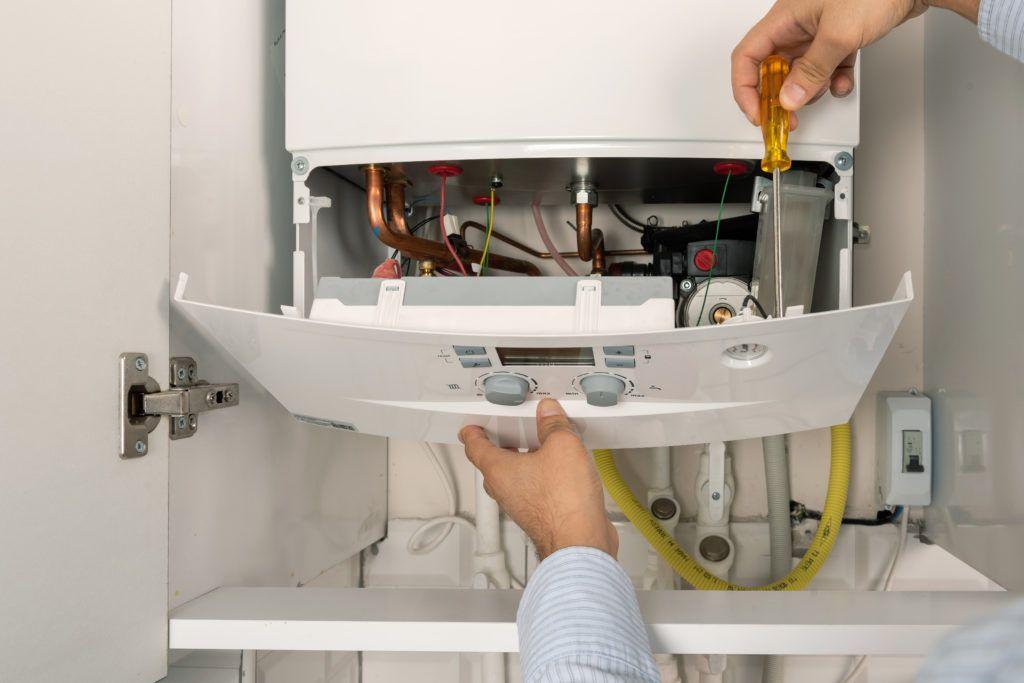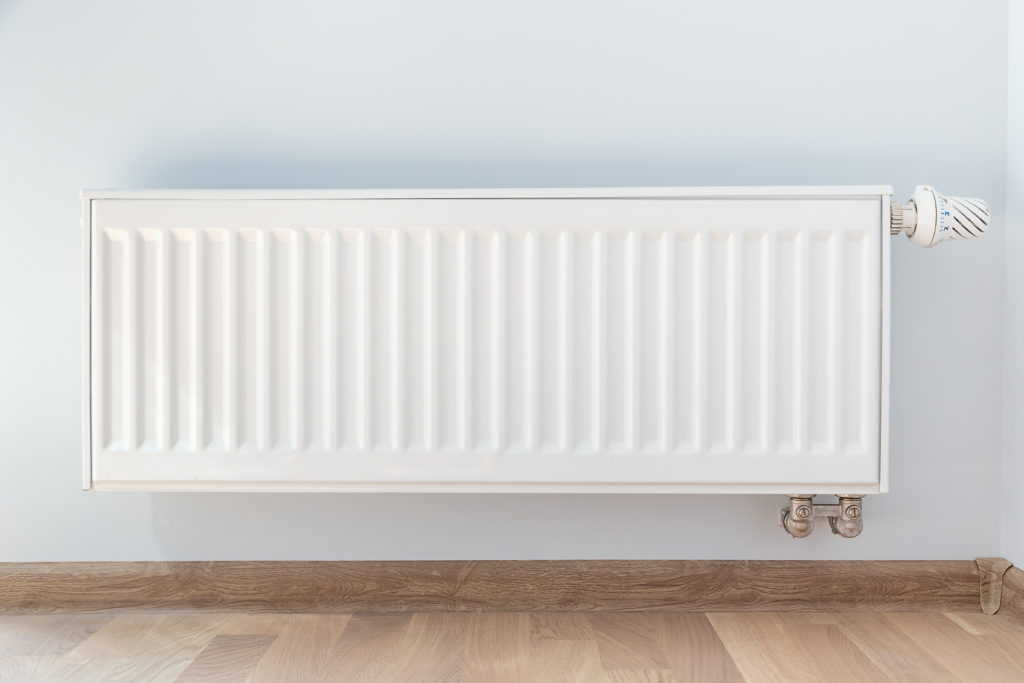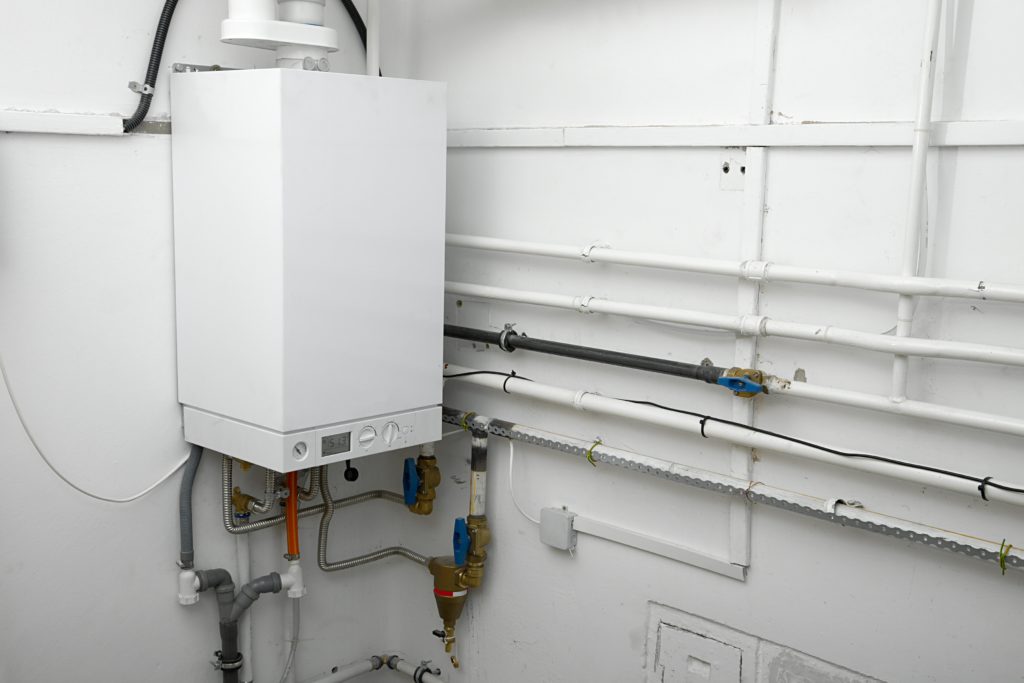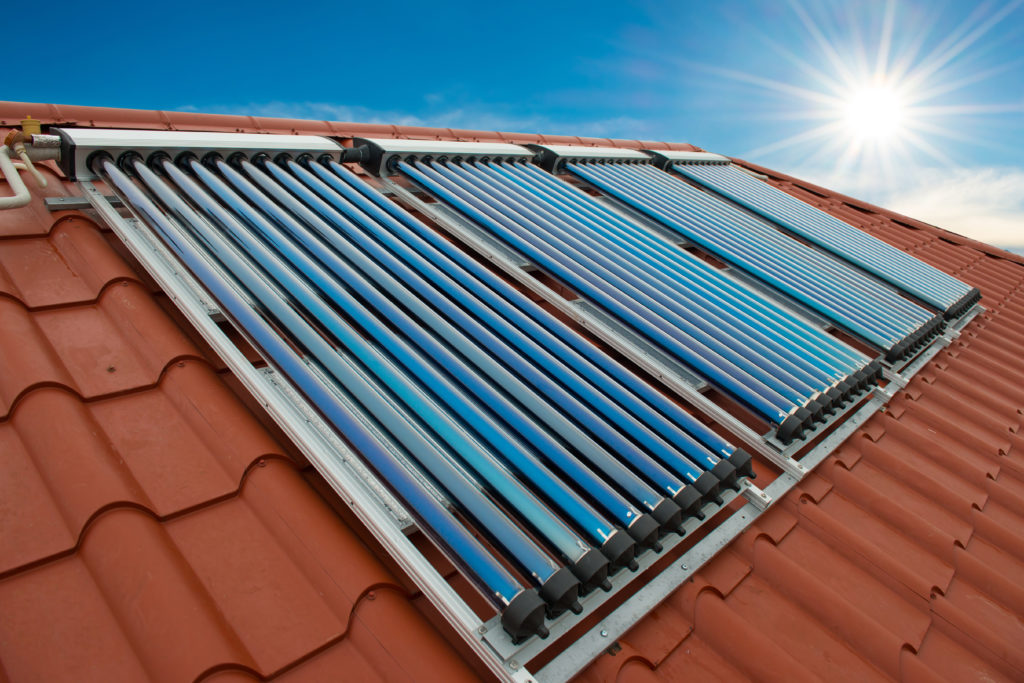The History of Heating Systems

Everything You Ever Wanted To Know About Heating!
Ever since man started the first fire, we’ve tried to warm ourselves with efficient central heating systems. Small fires turned into fireplaces with chimneys, which turned into the modern heating systems we see today. We have evolved to create many different home heating systems. Some heat systems have ducts and others bring heat to the home through the floor.
In this post, you will learn the different heating systems and their major components. You will also learn how to choose a new home heating system and a few ways to maintain your own central heating system.

History Of Heating Systems
One day, a man (or a woman, or a child) found fire. For thousands of years, humans tried to control their fires. The Romans came up with hypocausts, which were furnaces below homes, villas, and public baths. These furnaces needed the fire to keep burning constantly, so slaves were sent to the furnaces to tend to the fires.
After the Roman Empire fell, people started to insulate their homes with clay and straw to trap the heat from their hearths. Along with insulation, some built chimneys above their fireplaces to let the smoke go outside the home.
It wasn’t until the Industrial Revolution when other methods of heating were invented. Coal and oil were used as fuel for heating homes. Electrical systems came about at the turn of the 20thcentury; Albert Marsh is known as the “father of the electrical heating industry.”
Today, while many people still heat their homes by burning wood or coal, the three major heating systems are burning oil, electricity, and burning natural gas.
How Do Heating Systems Work?
There’s a common misconception about how to define “heat.” Instead of an object “possessing heat,” an object has internal energy that can be increased or reduced. Increasing an object’s internal energy is the proper way to define “heating.”
There are two ways to increase the internal energy of an object:
- Transfer energy to the object from a higher temperature (hotter) object – The most common way to increase the internal energy of an object is to create combustion and heat the object with a fire of some sort.
- Apply work – You can also increase the internal energy of the object by applying a force called “work” on the object.
There are three major components of every heating system:
- Heating source – This is the fuel and mechanical system that heats your home. Furnaces and boilers are the most popular sources of heating power. Some also use electricity or burn wood.
- Distribution – From the heat source, these distribution channels move the heat around the home. Forced-air systems use ducts, and radiators use steam or hot water to transfer the heat.
- Control system – Most of today’s heating systems use a thermostat to control the temperature of the room.
Types Of Heating Sources and Distribution Systems
In all heating systems, there is a primary heating appliance (a furnace or a boiler) that is usually located in the basement, attic, garage or mechanical room. A furnace pulls in cool air through the return ductwork, heats the air, and blows the warm air through a series of supply ducts. A boiler sends hot water or steam through pipes to radiators or convectors. These convectors spread the heat – “internal energy” – throughout the home.
Furnaces
Most Americans heat their homes with a furnace. Furnaces can be electric, gas-fired (either with propane or natural gas), or oil-fired. The most common way to distribute warm air throughout the home is through a duct system. If a home has a furnace, an air conditioning unit, or a heat pump, that home has a duct system (unless the system is a ductless mini-split).
The furnace can both heat the air and cool the air in a forced-air system if it is integrated with an air conditioning or heat pump system. The blower inside the furnace forces the heated or cooled air through the duct system, releasing the air in the home. In the ducts, air usually moves at about 700 feet per minute through galvanized tubes of steel. Some ducts are round or rectangular and are connected to a main rectangular trunk; others have round flexible ducts that are insulated.
Heat Pumps
The heat pump runs using only electricity, extracting heat from the outside air and delivering it indoors. In the summer, the heat pump works in reverse; it extracts heat from indoors and delivers it outside. This heat transfer is accomplished using the refrigerant inside the system via the refrigeration cycle.
There are two major types of heat pumps:
- Air-to-Air – This is the most common type of heat pump. Air source heat pumps transfer heat between the home and the outside air. Air-source heat pumps can reduce electricity use by up to 50% compared to electric furnaces and baseboard heaters. In the past, heat pump systems weren’t ideal for regions that have regular sub-freezing temperatures. Now, air-source heat pumps are more efficient and provide homeowners with an alternative to heat their home, even if they live in sub-zero climates.
- Geothermal – These heat pumps use either the earth or a water source to heat the home. Both earth and water have consistent temperatures, which helps reduce operational costs and energy use. Geothermal heat pumps are very energy-efficient and work well in specific applications.
Boilers
Instead of furnaces, some Americans use boilers to heat their home. These vessels or tanks produce heat from the combustion of natural gas, fuel oil, and coal and warm up water. From the boiler, pipes carry the water between 120 and 180 degrees Fahrenheit to the radiators in the living space. These radiators have a copper tube running through a row of sheet metal fins. This sets up a convective heating loop; air is pulled in at the base and flows out of the unit’s top.
Homes can be heated with boilers in a couple different ways:
- Steam – The steam from the boiler is distributed via pipes to steam radiators.
- Hot water – This is distributed with baseboard radiators or using a radiant floor system.
- Air – Some special boilers heat the air with a coil in their system.
Overall, steam boilers operate at a higher temperature than hot water boilers, which makes steam boilers less efficient than hot water boilers. Today, there are high-efficiency versions of all types of furnaces and boilers.

Radiant Heating
Another type of heating, called radiant heating, can have furnaces, boilers, or both. All radiant heating systems supply heat through the floors, panels in the walls, or panels in the ceiling. The heat is directed at the objects or people in the room without relying on moving air through ducts. Radiant heating is the feeling you get when you can feel the heat from the stovetop or the sun. A small pipe with hot water carries as much heat as a large duct full of hot air. The small pipes also fit easily in between studs and joists of the house, unlike large duct systems.
Each radiant heating system depends on the way the heat is transferred.
- Infrared radiation – This delivers heat directly from the hot surface to the people or objects in the room through the radiation of heat, which is called infrared radiation.
- Radiant floor heating – Also known simply as in-floor heating, this radiant heating depends on convection currents caused by heat rising from the floor.
From these two ways of transferring heat, radiant heating can be used through the air, electricity, or water. Radiant air floors have furnaces that pump air through the floor. Electric radiant floors pump heat from electric cables built into the floor. Hydronic radiant floors have copper or plastic tubes snaking underneath the floor, pumping hot water through the tubes and heating the home.
Besides heating with furnaces and boilers, there are alternative methods to heat your home.
Fireplaces, Wood Stoves, and More
Burning wood is how man used fire many millennia ago. From that time until the Dark Ages, most homes were heated with fireplaces. These fireplaces were not energy efficient; smoke carried the heat out through the chimney, and the smoke polluted the air. Now, most fireplaces have inserts placed in the masonry or hearth and a flue collar installed from the insert to the top of the chimney to be more energy efficient.
Wood stoves are the most popular appliances for burning wood to keep a home warm. Wood stoves are essentially enclosed fireplaces that have insulated fireboxes to reflect heat back to the flame. This lets the volatile gases burn faster. If the fire goes out, modern wood stoves burn oil or coal to keep the house heated. Pellet heaters are like wood stoves, but smaller and used only in one room of the house. Small organic pellets fuel the fire, and it’s controlled by a thermostat.
Electric furnaces, baseboard heaters, and wall heaters
Blowers in an electric furnace move air over a group of electric resistance coils, called elements. Baseboard heaters are like electric furnaces, but they draw in cool air through the bottom slot and let warm air exit the top slot. Electric wall heaters use an electric element to reflect heat back into the room.
Environmentally Friendly Solar Heating
Using the Sun’s rays to heat a home is an alternative. There are two types of active solar heating:
- Liquid – Fluid is heated by the sun and is collected in a collector, where the water can either be heated or cooled. These are best used with boilers and radiant heating systems.
- Air – Air-based systems heat air in an air collector, which absorbs the solar radiation and transfer that solar heat directly into the space or storage system.
If solar heating is not enough to heat the home, there are back-up systems for both liquid-based and air-based solar heating. Liquid systems are more often used when there’s a back-up storage system. Both air-based and liquid-based solar heating systems can supplement forced air systems.

Buying A New Heating System
To live comfortably, a quality HVAC system is important. Buying a new heating system can be overwhelming, with all the different variables you need to consider. What do you need to look for when you’re buying a new heating system?
Installation Guidelines
First, look to HVAC experts who will help you install your new heating system. There are experts for every heating system, and finding the best HVAC contractor for your project can be tough. When looking for your personal HVAC expert, look for the following traits:
- Online reviews – See how other customers rated the contractor’s services. Did they do a good job? How long do they take to respond to your questions?
- Expertise – What types of heating systems can they install? Will they look out for your best interest, or are they trying to sell a certain brand or heating system at all costs?
If you’re having trouble finding your own HVAC expert, check out our website. HVAC.com acts as an unbiased, trustworthy resource by connecting you with a great contractor from our network.
Energy Efficiency
There are two methods of measuring your heating system’s energy efficiency. The first measurement is AFUE, or Annual Fuel Utilization Efficiency. This measures how much energy is converted from burning fuel divided by the amount of fossil fuel used by the boiler or furnace. In mathematical terms,
The most efficient boilers and furnaces have 95-98% AFUE. Older systems are between 56% and 70% AFUE. Average heating systems have an AFUE rating of 80-83%.
Here at HVAC.com, we highly recommend that you purchase a heating system that is at least 95% efficient. The cost to upgrade to a high-efficiency unit is not very high compared to the amount of money saved on your energy bills each year, plus the higher efficiency units usually have better warranties and higher quality components.
For heat pumps, their energy efficiency is measured in HSPF, or Heating Season Performance Factor. This takes an average of how much energy the heat pump is using over a year.

Most heat pumps range from 7.7 to 10 HSPF. Today, laws require heat pumps to have a minimum of 7.7 HSPF.
Blower Motor
The blower motor is a major component of a forced air heating system. It controls how much heated air is coming into the home and has an impact on energy usage, comfort and noise levels. There are a couple different types of blower motors:
- Single-speed – There are only two settings for a single-speed motor. It’s either turned on or turned off. When turned on, the heater blows at 100% maximum capacity, making this motor relatively loud and inefficient.
- Variable-speed motors – These motors can ramp up and down and run at a variety of speeds based on how cold or warm it is outside and how much air flow is required in the home. A variable speed blower motor is the most energy efficient motor, and while it costs a bit more, we highly recommend this option.
Brands
In our opinion, we believe that every brand has its pros and cons. Instead of choosing a new heating system based on brand alone, we recommend you find the best contractor who will find the best solution for you. When a heating contractor has your best interests in mind, he will find the best brand for your situation.
We have noticed some contractors who install the right brand, but they didn’t install the heating system correctly. This lets the consumer believe it was the brand’s fault for creating a terrible heating system, but instead, it was the contractor’s fault.
At the end of the day, the energy efficiency and reliability of your new heating system depends greatly on the quality of the installation.
Heating System Maintenance
Regular maintenance is important; this helps with performance and prevents major problems in the future. Before you start fiddling with your system, call your local HVAC contractor. These experts can deal with any problem you face with your heating system. They can also do annual pre-season check ups to see if your unit is working properly.
If you’re going to do some preventive maintenance yourself, here are some safety tips before you start:
Shut Off Everything
This step is essential. You don’t want to burn yourself or cause more harm to your heating system. Below is a list of a few valves and switches to shut off before working:
- Thermostat – You can turn the system to the off position at the thermostat, but make sure to also cut off power and fuel connections before performing any maintenance.
- Boiler Shutoff Valve – This stops the water flow to the boiler and to other valves downstream.
- Burner Emergency Switch – This cuts power to a gas- or oil-burning circuit.
- Main Shutoff Valve – This controls the gas flow from the meter to the building. You can turn this valve off with an adjustable wrench.
- Propane Tank Service Valve – This controls the gas from the tank to the building.
- Circuit Breaker – If you have an electric system, flip the circuit breaker to cut off power to your electric elements
Simple Maintenance Tips
After shutting off the system, take a look at these major components:
- Check thermostat settings – Sometimes the settings on the thermostat aren’t aligned with the actual room temperature. Take a look at the settings to make sure you’re comfortable at home.
- Tighten electrical connections – Faulty electrical lines can reduce the life of your heating system. Also, this can create an unsafe environment for anyone in the home. Measure your voltage and current on motors, and tighten your electrical connections to keep you and your family safe.
- Lubricate all moving parts – Over time, friction can wear your motors down. A worn-down motor also needs more energy, resulting in high electric bills. Use an appropriate lubricant on any moving parts.
- Check all gas connections – If you smell gas in your home, you might have a gas leak coming from your heating system. A leaky connection is a fire hazard and can create health problems for you and your family. Take a look at your gas pressure, burner combustion area, and heat exchanger connections. Check to see if they’re clean and ready to operate.
- Clean your filters – In a duct system, filters collect dirt and keep your air clean. Over time, they need cleaned or replaced. If left unchecked, dirty filters can damage your system and increase your energy costs. Once a month, check your central air conditioner, furnace, or heat pump for dirty filters and replace as necessary.
- Keep joints sealed – Duct systems have many different pieces of sheet metal connected to one another. If your ducts aren’t fit properly and have air leaks, you could have higher energy costs. Seal your duct joints to keep the air locked in the ducts.